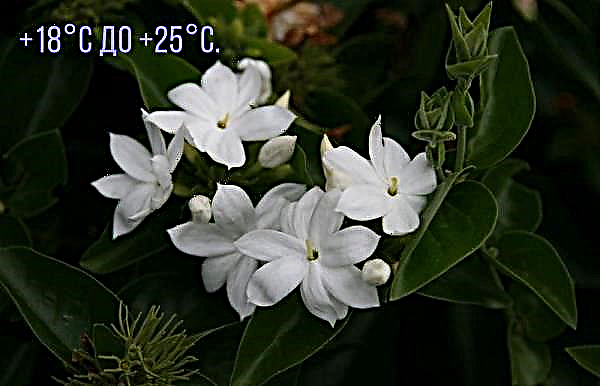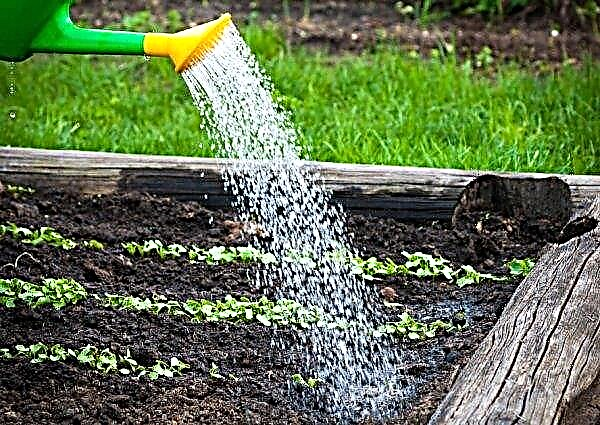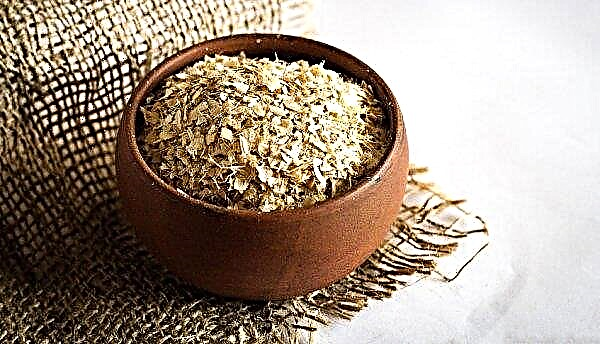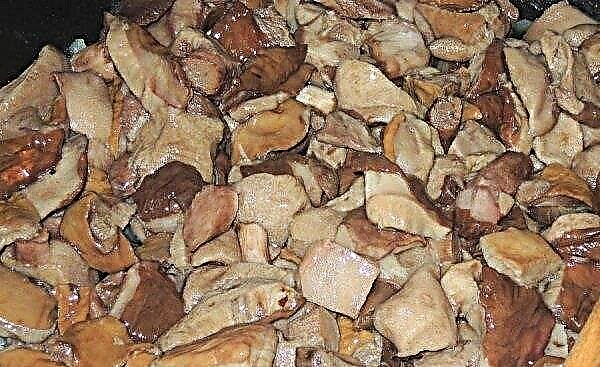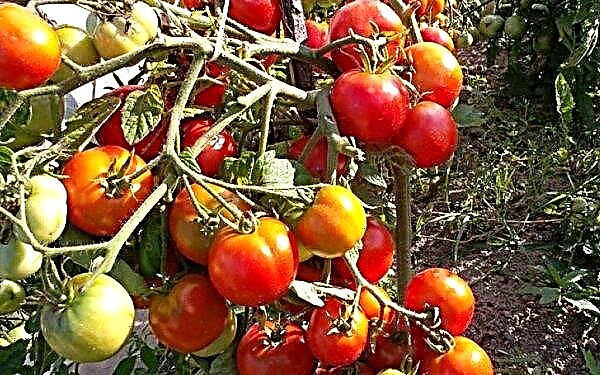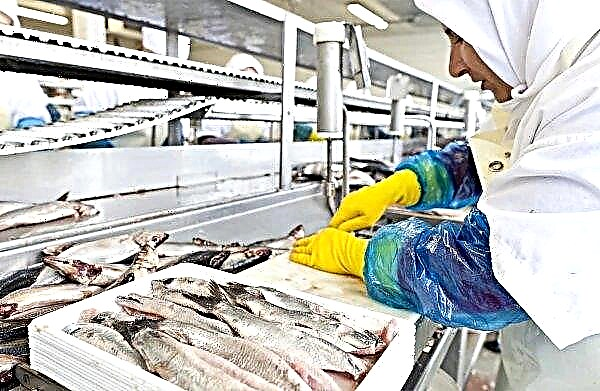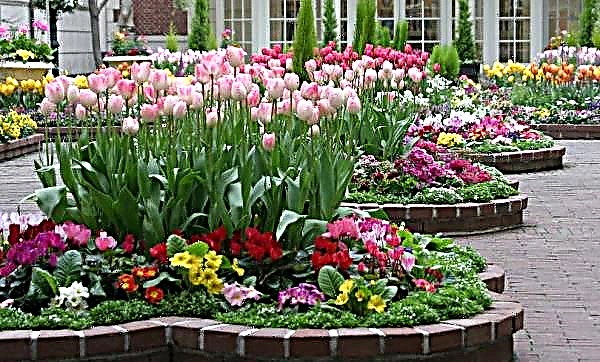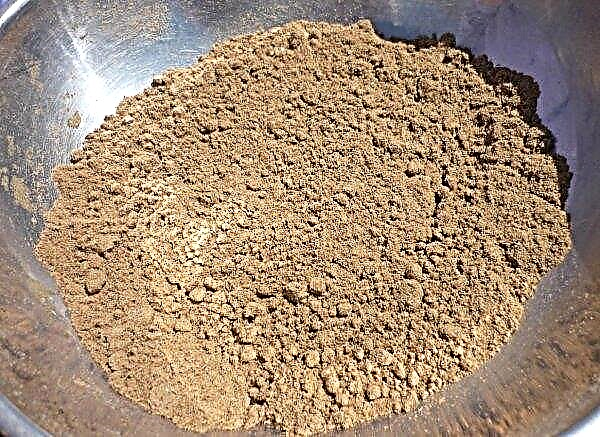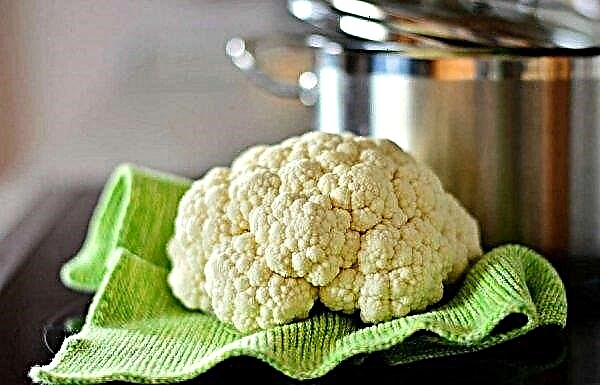Cucumbers are included in the list of vegetables that grow well in greenhouses and greenhouses, so it is possible to enjoy their taste almost all year round. To do this, it is enough just to choose the right varieties and create suitable conditions for development and ripening. We will talk more about the features of growing cucumbers in greenhouses in this article.
The best varieties of cucumbers for growing in a greenhouse
There are many varieties of cucumbers that bear fruit in greenhouse conditions, among which the early self-pollinated and parthenocarpic varieties are especially worth highlighting. These may include the following:
These may include the following:
- Goosebumps - a high-yielding hybrid, characterized by the absence of bitterness and fruits (8-12 cm) with black spikes;
- Dynamite - variety of parthenocarp with cylindrical cucumbers. In length, they can reach up to 14 cm, and their skin is covered with light brownish down;
Did you know? The vegetable received its name from the Greek "aguros", which translates as "immature, unripe." After all, cucumber is really consumed at the time of its immaturity, because it is bitter when ripe, has a hard peel and large seeds.
- Trump card. This is a representative of gherkins, its fruits rarely exceed 10 cm, so it is ideal for canning;
- Sarovsky - an unpretentious variety whose seedlings do not suffer from low temperatures, insufficient lighting and at the same time give a high yield;
- Matilda - a hybrid of self-pollinated. The fruits of this species are cylindrical in shape, the surface is rough, slightly spiky;
- Bettina - a variety of gherkins, which bears fruit well even without adequate lighting;
- Pinocchio. This early ripe variety is planted almost everywhere, since it is cold-resistant and not afraid of temperature changes. Its fruits are large, with characteristic tubercles, without bitterness;
- Zozulya - a variety that is distinguished by white stripes on the peel and long ripening (does not turn yellow for a long time);
- Amur - a high-yielding species that can produce up to 30 kg per 1 sq. Km. m with proper care.
Varieties suitable for greenhouses can be bought in almost every garden shop (most manufacturers label packages with seeds for greenhouses and covered ground in an appropriate manner).
Important! To check the seeds, water is used: they collect liquid at room temperature in a container and pour seed there. Quality specimens sink to the bottom, and bad ones come up. For fidelity, you can stir water with a spoon several times.
Someone prefers to take them from gardeners they know or use their blanks from last year's harvest. But in any case, before planting the seeds you need to check and sort the pacifiers.
Preparation for landing
Before planting, the seeds must be prepared. To do this, they are immediately wrapped in gauze moistened with warm water immediately before disembarkation. In addition, there are several important conditions that must be observed when planting cucumbers.
When to plant cucumbers in a greenhouse
The timing of planting cucumbers depends on climatic conditions. In cold and mid-latitudes, this occurs in the second half of April, or even in early May, while in the south the weather allows this to be done at the end of March.
These terms are conditional, because regardless of the date on the calendar, before planting, it is always necessary to make sure that the soil is sufficiently warm.
Temperature can be determined using a thermometer or alternative method. To do this, remove 10 cm of the top layer of soil and put a palm on it. If after a minute and a half the hand freezes, then it is too early to plant cucumbers. In this case, the soil needs to be warmed up for planting.
To do this, sawdust, fresh hay or manure to a depth of half a meter is usually buried in the ground.
Greenhouse preparation
The greenhouse for cucumbers has its own characteristics even at the construction stage, since the height of the structure itself is very important here. If for other plantings this question is not fundamental, then cucumbers require at least 2 m of height for growth. In such conditions, they will stretch up and give a richer crop.
Also take care of the presence of fasteners on the frame, where it will be possible to suspend steam-repellent material: it will help maintain moisture and increase the juiciness of the fruit.
Did you know? On some Pacific islands, cucumbers are used as evidence of well-being. So, the groom during the matchmaking needs to show the stocks of this vegetable to the parents of the future bride to obtain a consent to marriage.
If wooden structures were used in the construction of the greenhouse, open them with oil paint. With this protection, living creatures from wood will not be able to harm the seedlings.
Immediately before planting the seeds, provide a suitable air temperature in the greenhouse: during the day - +22 ... + 28 ºC, and at night - +17 ... + 19 ºС. Moreover, the difference between them should not be more than 5–7 ºC.
A higher temperature will stimulate the accelerated growth of seedlings, and then the stem will weaken, unprepared for such a load. And at lower degrees, plant growth will slow down. Pay attention to the humidity in the greenhouse. On sunny days, 85–90% is considered the best indicator, and on cloudy days, 75–85%.
To ensure this level of humidity, as well as reduce temperature fluctuations in the greenhouse, use water. Place 200-liter dark-colored metal barrels of water at the ends of the room and do not cover them.
During the day, such "batteries" will heat up, increasing humidity, and at night they will warm the air, giving off their heat.
Soil preparation
Slightly acidic and neutral soils (pH 6.5–7) are suitable for growing cucumbers.
Greenhouse soil begins to be prepared in the fall.
For this, the soil is nourished by:
- ashes;
- compost;
- manure.
Important! In this case, fertilizing the soil with manure, mix it with the ground, since in its pure form the substance can burn out the roots of plants.
Before adding fertilizers to the ground, inspect them for the presence of larvae to prevent pests in the greenhouse. Then in the autumn, after top dressing, the soil is well dug up, and in the spring they are treated with a sulfur block or any other protective agent.
2-3 weeks before planting cucumbers rid the soil of extraneous vegetation. Immediately a few days before planting, they begin to loosen and irrigate the earth in order to nourish it with oxygen. If you wish, you can even add sawdust to the soil: they will retain water and protect the plants from drying out.
How to plant cucumbers in a greenhouse
With experience, each gardener has his own skills in planting greenhouse cucumbers, based on their own experience and the characteristics of the local climate. But there are important points that must always be observed.
Cucumber planting technology
There are two methods for planting cucumbers in a greenhouse - seeds and seedlings. We will talk about the features, advantages and disadvantages of each of them further.
Did you know? Among the ardent fans of cucumbers was Napoleon. The well-known commander even announced an award, the modern equivalent of which is equal to 250 thousand dollars, to an inventor who will find technology to preserve the freshness of this vegetable on campaigns. But such a craftsman was not found.
Seeds
Plant both sprouted and dry seeds. In the first case, instances with sprouts of no more than 0.5 cm are suitable, otherwise they will make a weakened plant.
The landing process itself is as follows:
- Two sunflower seeds are lowered flat into a dug hole 10-15 cm deep (the stronger one will grow in the future).
- If the earth was not fertilized in advance, then a little compost, a pinch of ash or charcoal are also added to the hole.
- Then the seeds are sprinkled with earth.
- Top hole is watered with plenty of warm water.
 This method is less troublesome, it is successfully used in the southern latitudes, where the earth warms up early. In this case, the plants ripen a little later (by 2-3 weeks) in comparison with the seedling method.
This method is less troublesome, it is successfully used in the southern latitudes, where the earth warms up early. In this case, the plants ripen a little later (by 2-3 weeks) in comparison with the seedling method.Important! It is necessary to pour water from the side, and not into the center, so as not to wash the seeds.
Seedlings
Planting cucumbers with seedlings increases the fruiting period and the amount of yield, but it requires active care and attention.
First you need to prepare the container. You can plant seedlings in specialized rectangular containers (save space), disposable cups or any boxes. This process begins 30 days before the planned planting of seedlings in the greenhouse. Then, by the desired date, 3-4 leaflets will already appear on the stems.
Important! It is necessary to observe this schedule, since overexposed seedlings begin to weaken, may not be taken at all in the greenhouse. But even if the seedlings take root, a large harvest should not be expected from them.
Whatever container you choose for planting seedlings, it is important to properly prepare the soil in it:
- A layer of about 2 cm of sawdust is laid on the bottom.
- Then lay a layer of earth (not more than 5 cm) mixed with humus and peat (1: 1).
 Next, it is important to plant the seeds correctly:
Next, it is important to plant the seeds correctly:- Dip them at an angle of 45º nose up. It is from the nose that the root will grow, which, having made a natural bend, will go into the ground. Thanks to this, the seed will drop the peel and make it possible to grow the embryo of the stem. If the plant is planted nose down, then not all instances have the strength to lose their peel, and they simply die.
- If you are planting in disposable cups or containers, then put one seed per container. When planting in large pots or boxes, keep a distance of at least 8 x 8 cm.
- Having planted the seeds, place the containers with them denser to each other and cover with plastic wrap so that the temperature there remains at the level of +25 ... + 26 ºС.
- Shoots usually appear on the 4th – 5th day, after which the film can be removed. After that, the plantations themselves need to be spread so that they do not touch each other with leaves - then each plantation will receive a sufficient amount of light.
For the period of seedling growth, maintain indoor temperature at +21 ... + 23 ºС during the day and +18 ... + 20 ºС at night, and humidity - 70–75%. The readiness of seedlings for planting is determined by the leaves: transplant is allowed after the appearance of the first leaf, but no later than the 4th-5th. If possible, it is better to transplant seedlings in the evening.
Did you know? Cucumbers are not only green, but also snow-white, yellow, red. One of the most exotic variations of this vegetable is momordica - a cucumber variety whose mature fruits resemble a yellow-orange jaws of a crocodile with a protruding red tongue.
How far to plant
To be extremely precise in this matter, the distance depends on the variety of cucumbers. However, in most cases, planting seeds or seedlings with a distance of 30-50 cm between the bushes is considered optimal. The landing process itself is as follows:
The landing process itself is as follows:
- First, level the earth on a future bed.
- Then outline the approximate places for the holes.
- The holes are dug to a depth of 25 cm and, if necessary, fertilized.
- Near each hole put a rod or stake higher - they are useful for gartering plants.
Important! To simplify the process of marking the beds, many gardeners make a marker - a tool in the form of a stick 1.5–2 meters long, on which special marks are made every 50 cm.
If the area of the greenhouse does not allow plants to be planted at such a distance, then there are two ways out of the situation:
- pick varieties that do not require a lot of space for growth;
- reduce the number of plantings.
Otherwise, your plants will receive less light, moisture, and therefore will not bring a rich harvest.
Plant Shaping and Garter
An important aspect of ensuring the future harvest is the garter of grown sprouts. To do this, you need a wire stretched at an altitude of 2–2.2 m above the cucumber row, and the same rods that were dug near the hole during landing. The garter itself and the formation of the bush are carried out as follows:
The garter itself and the formation of the bush are carried out as follows:
- The plant stem is tied to a support on the 3-5th day after transplanting or after reaching 10-15 cm in length when planted with seeds.
- Then take the twine in the form of segments of 250 cm.
- The upper end of the segment is tied to a wire, and the lower - under the second or third leaf of the seedling.
- In the future, as the stem grows, make sure that it grows up, braiding this twine.
- When the 9th leaf appears on the plant, they begin to form a bush. To do this, pluck new branches at the level of the three lower nodes.
- After the plant reaches the wire, the stem is twisted around it and fixed.
Did you know? The first mention of cucumber in the history of mankind appeared 6 thousand years ago.
This is the main part of the formation of the cucumber bush. Further, it is enough to ensure that the plant does not allow lateral shoots in the row-spacing (they should be “turned” back inside the row), as well as periodically pruning yellowed leaves that have already produced branch fruits.
Care for cucumbers during cultivation
Proper preparation of seedlings, their planting should be accompanied by high-quality care of plants - a set of measures to ensure comfortable conditions for the development and fruiting of cucumbers.
Important! Since the cucumber is very fond of moisture, the humidity in the greenhouse must be kept at a high level for as long as possible, without dropping below 75%. So you extend the life cycle and fruiting of your plantations.
Temperature mode
The temperature and humidity in the greenhouse also undergo changes as the plantings grow. If during planting indicators at the level of +22 ... + 28 ºC were necessary, then healthy growing plants would need +21 ... + 25 ºC. They are more tolerant of cooling, but do not abuse their cold resistance.
Greenhouse ventilation
To maintain high humidity in the greenhouses, film materials are actively used that do not allow water vapor to pass through. However, in such conditions, access to fresh air is also limited, and this is not very good. Stagnation of air can provoke the development of a number of diseases in cucumbers, so it is necessary to do daily airing.
They are led through the upper windows to prevent drafts, and on sunny days when it is not so cold.
How much time is needed for a full ventilation is hard to say for sure, because it all depends on the size of the greenhouse. But it is important at the same time to monitor the temperature in the room and prevent it from lowering by more than a few degrees.
Watering
For cucumbers, both overdried and excessively moistened soil are equally harmful.
Simple recommendations will help you to prevent the death of ovaries, root rot, and a decrease in yield.
- in hot time, water the plants every day at the rate of 5-10 liters per 1 sq. m;
- on cloudy days, watering can be carried out as necessary;
- watering is in the evening, so that the water has enough time to warm up in the sun. In addition, cucumber fruits grow mainly at night;
- if you put a sprayer on the watering can, then the soil on the roots will be less eroded;
- for watering in cold weather, warm the water to +25 ºС.

Top dressing
The first feeding of cucumbers is carried out on the 25-30th day after planting. It provides a supply of nutrients to young plants. Complex fertilizers are usually chosen for her. If you buy fertilizers, then when using them, it is better to follow the instructions on the package.
If it is absent or during the use of folk methods, remember that the cucumber prefers top dressing in liquid form.
Important! But at the same time, the plant does not like highly concentrated solutions: take no more than 10 g of fertilizer per 1 liter of water.
It is better to enrich the bed with fertilizers in the morning in cloudy weather or in the evening if the day was hot.
As for the subsequent top dressing, they are carried out every 7-10 days, if the plant requires it.
You can determine what the vegetable lacks by the state of its bush:
- slow growth, a pale green color, the gradual death of the leaves will indicate a lack of nitrogen (if the plant receives enough light);
- small leaves of green-blue huewhich, after drying, turn completely black, is a sign of insufficient phosphorus in the soil. In greenhouses, this is extremely rare, but it is worth knowing about the features of such a problem;
- if you notice the appearance brown edges on the leavesand then their gradual death occurs, underdeveloped fruits appear, which means that the plants lack potassium;
- intervein chlorosis (when the leaves turn yellow and only the veins on them retain a green color) indicates the need for magnesium.
 For top dressing in such cases, you should use:
For top dressing in such cases, you should use:- ammonium nitrate;
- ammophos;
- superphosphate;
- potassium sulfate;
- potassium nitrate, etc.
Important! Avoid potassium chloride and potassium salt, as this culture negatively reacts to chlorine in their composition.
You can make high-quality fertilizer with your own hands, using organic waste from birds, cattle, etc. It is enough to dilute poultry droppings (1:20) or manure (1: 5) in water and let it thin for 2-3 days before use .
But you can do such dressing only on condition that the animals were healthy and there is no threat of plant infection.
Cultivation of the earth
The intensity of soil loosening depends on its density: the higher it is, the more often you have to treat the soil with a pitchfork. If there are no problems with the soil, then after watering or top dressing it is enough to loosen the top layer of the earth in order to simplify the access of air. Sometimes during this procedure white threads become visible - the roots of the plant, which means that cucumbers need fresh soil. On average per season, there may be 2-3 land fillings with layers of 2-3 cm.
Sometimes during this procedure white threads become visible - the roots of the plant, which means that cucumbers need fresh soil. On average per season, there may be 2-3 land fillings with layers of 2-3 cm.
Did you know? In Iran, a cucumber is considered a fruit and served for dessert.
Features of growing cucumbers in a polycarbonate greenhouse
Polycarbonate is a material with increased ductility and strength, due to which the greenhouse from it perfectly tolerates bad weather and heavy rainfall.
The advantages of such a greenhouse include:
- the ability to grow cucumbers year-round;
- ease of installation;
- special topcoat, due to which the harmful effects of the sun are reduced;
- resistance to precipitation.
The polycarbonate greenhouse also has disadvantages:
- the need to clear the coating of snow, ice;
- if gaps remain between the sheets of material, this will lead to the appearance of fungi and parasites in the greenhouse.
 Thanks to the improved thermal insulation of the polycarbonate greenhouse, planting cucumbers in it is possible much earlier than in ordinary greenhouses.
Thanks to the improved thermal insulation of the polycarbonate greenhouse, planting cucumbers in it is possible much earlier than in ordinary greenhouses.Important! And to make the crop richer, use self-pollinated varieties that are ideal for these conditions.
Possible problems and solutions
Sometimes in the process of growing cucumbers characteristic problems may arise, among which:
- Ovaries do not appear. Without ovaries, the formation of fruits is impossible, so if they do not grow, turn yellow or wilt, then you should understand the problem. The reason may be in increased humidity, heat, a small number of male inflorescences, which is typical for hybrid varieties. They are very demanding, so they need frequent top dressing (use mullein with urea for this) and comfortable conditions. Sometimes the ovaries dry due to too rare fruit collection. Try to pick cucumbers every day, and then the bush will not spend extra energy on overgrowths, but will direct them to new ovaries.
- The fruits ripen slowly. In such cases, “poultices” will help: in sunny weather, first water the soil abundantly in the greenhouse, and then close it carefully. An hour after this, you can start to gradually air the room.
- Ripe cucumbers are bitter. Bitterness depends on a number of factors: variety, growing conditions, but most often it appears in overripe fruits. 8-12 days are enough for a cucumber to ripen, and all that is more is already to the detriment of its taste.
- Drying of the lower branches. Often in hot weather, you can observe how the leaves dry out at the bottom of the bush, although in the upper part the plant blooms and sprouts. A similar situation indicates a lack of humidity in the air.
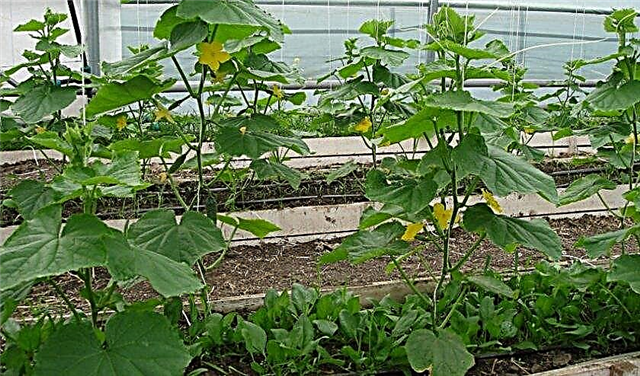 You can fix it as follows:
You can fix it as follows:
- gradually, in a few days, tear off the dried leaves;
- then carefully remove the stem from the support and lay it in a semicircle on the ground;
- in this position it must be fixed and sprinkled with soil, leaving only the top with leaves and flowers open;
- then you need to regularly water and feed the plant until it resumes growth.
Did you know? In Cyprus, sweet jam is made from cucumber.
Growing cucumbers in a greenhouse will allow you to regularly enjoy fresh vegetables and get a crop almost year-round. Today on sale you can find excellent varieties for growing in greenhouses, and creating suitable conditions for them is quite simple if you follow the recommendations provided.
It is important to maintain temperature and humidity in the greenhouse, to monitor the condition of plants in order to prevent diseases, and then a rich harvest is guaranteed.

 You can fix it as follows:
You can fix it as follows:

